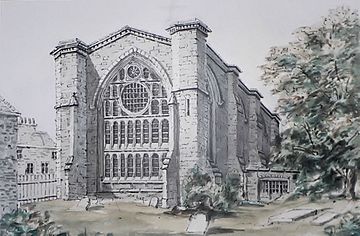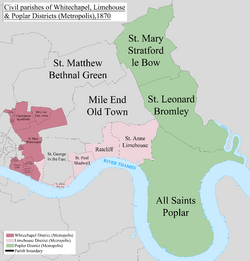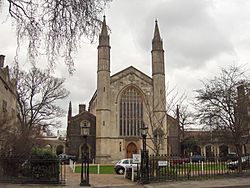Royal Foundation of St Katharine facts for kids
St Katharine's by the Tower was a very old church and hospital located right next to the famous Tower of London. Its full name was the Royal Hospital and Collegiate Church of St. Katharine by the Tower. It was first started in 1147. The original buildings were taken down in 1825 to make way for the St Katharine Docks, which got its name from the church. Later, the church was rebuilt in a different part of London. After 123 years, it moved back to the East End. This church was special because it was a Royal Peculiar, meaning the King or Queen directly controlled it. The area around it was also special, acting like its own small town, which later became a civil parish before it was closed in 1895. Today, the special Royal Peculiar still exists as the Royal Foundation of St Katharine.
Contents
A Look Back: St Katharine's History
How It Began: The Medieval Years
The church and hospital were founded by Queen Matilda in 1147. She was the wife of King Stephen. She started it to remember her two children, Baldwin and Matilda, who had died as babies. They were buried at the Priory Church of Holy Trinity. Other queens, like Eleanor of Castile and Philippa of Hainault, gave more money and land to help the church.
The community included three brothers, three sisters (who had equal rights), a bedeswoman, and six poor clerks. They were all led by a Master. It was a religious place and a hospital for people who were poor or sick, right by the Tower of London. In 1273, Queen Eleanor made a new rule. She said that only the Queens of England could be in charge of the Foundation. For 678 years, the Foundation kept helping people in the East End of London.
In the 1400s, St Katharine's was famous for its music, almost as much as St Paul's Cathedral. In 1442, it got a special Charter of Privileges. This made its 23-acre (93,000 m2) area a Liberty. This meant it had its own prison, officers, and court. It was completely separate from the rules of the City of London.
Changes in the Early Modern Period
Because it was a Liberty and protected by the Queen Mother, St Katharine's was not closed down during the Dissolution of the Monasteries. Instead, it was changed to fit the Protestant religion. By this time, there were about 1,000 houses in its area. Many foreigners and people without homes lived there. The houses were packed together on narrow streets with strange names like Dark Entry and Cat’s Hole. Many were in bad condition.
Since the City of London's rules didn't apply here, many foreign craftspeople came to live in the Liberty. Sailors and river workers also moved there. St Katharine's continued through many religious changes. It survived when England became Catholic again under Queen Mary. It also survived when it returned to Anglicanism under Elizabeth I and during the Puritan Revolution.
Even though many people lived there, the Liberty had a lower death rate during the Great Plague. This was half the rate of other areas nearby. However, its community of lay brothers and sisters caused problems with some extreme Protestants. For example, a mob tried to burn it down in the 1780 Gordon Riots. Luckily, a small group of people who supported the government saved it.
The 1800s and Beyond
By the 1800s, London was one of the biggest cities in the world. It needed more docks for its huge shipping business. People wanted another dock closer to the Pool of London and the heart of the City. So, St Katharine's was chosen as the spot in 1825. Some people didn't want such an old place to be torn down. But many others thought building the docks was a good idea. They believed it helped get rid of some of the unhealthiest homes in London. The old buildings of St Katharine's Liberty were demolished. The people living there had to move, and the St Katharine Docks were built.
The area of St Katharine's by the Tower became part of the Whitechapel District in 1855. In 1866, it became a civil parish. This happened after its special "extra-parochial" status ended. The parish then became part of the County of London in 1889. In 1895, it was closed as a parish and joined with St Botolph without Aldgate.
The institution, now called the Royal Foundation of St Katharine, moved to Regent's Park. There, it became a place with homes for poor people. It stayed there for 125 years. A new St Katharine's Church was built there between 1826 and 1828. Ambrose Poynter was the architect.
In 1948, St Katharine’s moved back to East London. It is now in Limehouse, about a mile from its first location. It became a retreat house, a quiet place for reflection. Father John Groser became the Master. Members of the Community of the Resurrection helped with worship and service. This Community looked after the Foundation for about 45 years. In 2004, St Katharine’s updated its buildings. It added a retreat and conference center. This made its hospitality available to more churches, charities, and other groups.
The old chapel of St Katharine at Regent's Park is now the Danish Church.
Leaders of the College
Here are some of the people who led the College over the years:
- Gilbert (1257)
- Walter de Runachmore (1263)
- Thomas de Chalke (1266)
- Stephen de Fulborne (1269)
- Thomas de Lechlake (1273)
- Symon de Stanbridge (1288)
- Walter de Reading (1295)
- John de Sandale (1315)
- Richard de Lutishall (1316)
- Robert de Bast (or Basse) (1327)
- William de Culshoe (1336)
- William de Erldesby (1340)
- Walter Watewany (1347)
- William de Hogate (1348)
- Dr. Paulet (1349)
- Paul de Monte-Florio (1351)
- John de Hermesthorp (1368)
- William de Kildesbey (or Killesby) (1377)
- Richard Prentys (1402)
- William Wrixham (1412)
- John Francke (1438)
- Thomas de Beckington (1444)
- John Delabere (1446)
- William Cleve (1449)
- Henry Trevilian (1461)
- Lionel Woodville (1475)
- William Wernham (1484)
- Richard Payne (1499)
- John Preston (1508)
- George de Athequa (1527)
- Gilbert Latham (1536)
- Thomas Seymour, 1st Baron Seymour of Sudeley (1547)
- Sir Francis Fleming (1549)
- Francis Mallet (1554)
- Thomas Wylson (1561)
- David Lewis (1581)
- Ralph Rokeby (1587)
- Julius Caesar (1596)
- Sir Robert Acton (1636)
- Dr. Coxe (1653)
- Henry Montague (1659)
- George Montague (1661)
- William Brouncker, 2nd Viscount Brouncker (1681)
- Sir James Butler (1684)
- Louis de Duras, 2nd Earl of Feversham (1698)
- Sir Henry Newton (1709)
- William Farrer (1715)
- George Berkeley (1738)
- Edmund Waller Jr. (1747)
- Stephen Digby (1786)
- Maj. William Price (1800)
- Col. Edward Disbrowe (1816)
- Maj-Gen. Sir Herbert Taylor (1818)
- William Ashley (1839)
- Rev. J.H.S. St. John Blunt (1879)
- Rev. Arthur L.B. Peile (1889)
- Rev. Severne Majendie (1914)
- Rev. St. John B. Groser (1948)
- Rev. Henry Cooper (1963)
- Rev. Augustine Hoey (1968)
- Rev. Jack Guinness (1972)
- Rev. George Sidebotham (1975)
- Rev. Christopher Lowe (1982)
- Rev. Malcolm Johnson (1993)
- Rev. Prebendary Ronald Swan (1997)
- Rev. Prebendary David Paton (2006)
- Rev. Mark Aitken (2013)
- The Venerable Roger Preece (2019)
Notable Burials at St Katharine's
Several important people were buried at St Katharine's by the Tower:
- John Holland, 2nd Duke of Exeter
- VADM William Rainsborough, who was an MP and an English ambassador.
- Anne Stafford, Countess of March, who died in 1432.
- Thomas Walsingham, who died in 1457. He and his wife, Margaret, were buried there.
Population Changes Over Time
The number of people living in St Katharine's by the Tower changed a lot over the years. Here's a look at the population during different census years:
| Year | 1801 | 1811 | 1821 | 1831 | 1841 | 1851 | 1871 | 1881 | 1891 |
|---|---|---|---|---|---|---|---|---|---|
| Population | 2,652 | 2,706 | 2,624 | 72 | 96 | 517 | 241 | 104 | 182 |
Images for kids





